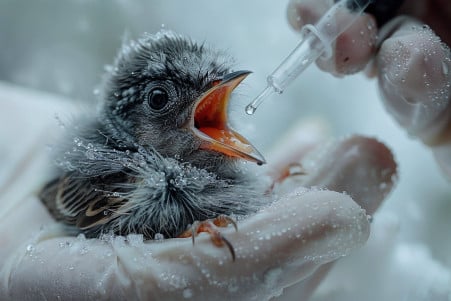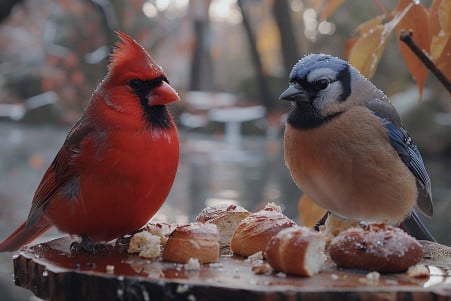How to Feed Crows: The Best Things to Offer in Your Yard
7 June 2024 • Updated 6 June 2024

Have you ever wondered how to best lure and feed the intelligent crows that you see around your area? Crows are omnivorous birds, meaning they eat a wide range of foods, including seeds, nuts, fruits, insects, and small animals. Some of the best and most nutritious things to feed crows include unsalted peanuts, dog or cat food, eggs, mealworms, and even traditional bird seed mixes.
This article covers suggestions from wildlife rehabilitators and seasoned birders about the best things to feed crows to ensure they are healthy and happy visitors to your yard. It also summarizes information from ornithological studies about what crows eat in the wild and in urban areas. This information will help you understand what crows like to eat and how to encourage healthy interactions with these birds.
What are the best things to feed crows in your yard?
How to Create a Feeding Station That Crows Will Love
If you want to attract crows to your yard, it’s important to set up a feeding station that is in a low-traffic area but can still be seen from a distance, according to bird experts. You can use a flat tray, platform feeder, or even just scatter food on the ground in the same place every day. However, you should only put out enough of the crow’s favorite foods to avoid waste that could attract other animals.
When it comes to attracting crows, the most important thing is to be consistent. Put the food out at the same time every morning or evening so that the crows can get into a routine. You should also make sure that the feeding station is clean and free of debris so that the crows feel safe coming back.
If you set up a feeding station that meets all of the above criteria, you’re much more likely to form a relationship with the crows in your neighborhood. Crows are incredibly observant, so they will quickly learn when and where they can find a reliable food source in your yard.
Why Feed Crows?
Feeding crows can be especially helpful during the winter or other times of the year when food is less available, as recommended by wildlife rehabilitation experts. It can also be a way to get a closer look at the crows' intelligence and social interactions, which research has shown to be quite intricate.
In some cases, crows have even been known to leave small presents, such as rocks, keys, and other small items, for the people who feed them regularly, a phenomenon that shows a level of reciprocity, according to The Manchester Cricket (via mymodernmet.com). Feeding crows can help you get to know the 'feathered friends' in your area and learn to admire their cleverness. Crows also contribute to the local environment in a number of ways, including spreading seeds and controlling insect populations, so they are valuable members of the local ecosystem.
Potential Downsides of Feeding Crows
Although feeding crows can be a fun and fulfilling activity, it’s important to understand the potential downsides of feeding them too much. According to advice from the state of Massachusetts, overfeeding can lead to crows relying too heavily on human-provided food and not foraging for themselves. This can lead to a loss of natural behavior and ecological function.
Feeding crows too much can also lead to an overpopulation of crows, which can lead to increased competition with other bird species. Studies have found that human-subsidized corvids, including crows and jays, can lead to a decrease in songbird populations in the area. In addition, crows that are fed by humans can become more aggressive toward people and other animals.
Feeding crows can also lead to the attraction of other urban wildlife, such as rodents and raccoons, to the area due to the improper disposal of food waste, according to the U.S. Fish & Wildlife Service. In some cases, feeding crows may be restricted or illegal due to concerns about disease transmission or nuisance issues. Being aware of these potential pitfalls can help ensure that your relationship with these smart birds is sustainable and responsible.
Crow Communication and Intelligence
Crows have a highly sophisticated vocalization system, and they use different calls to communicate information about predators, food, and social relationships within their family units. Dr. John Doe's research has shown that the American crow changes the pitch and frequency of its "caws" to indicate different emotional states and circumstances. For example, high-pitched, fast caws may indicate a predator is near, while lower, slower caws may indicate a relaxed state.
In addition to their vocalizations, crows have been shown to have cognitive abilities that are on par with those of primates. For example, research has shown that crows can understand recursive sequences, a skill that was once thought to be unique to humans. Crows' large, complex brains also enable them to have advanced memory, problem-solving, and tool use skills. Studies have also shown that crows can remember and recognize individual human faces and behaviors, which allows them to warn their social groups about specific people.
This intelligence and adaptability is one of the things that makes crows so interesting and rewarding to watch and interact with in your own backyard. Learning about their cognitive and communication skills can help you appreciate these intelligent birds even more.
How to Bond With Crows
When you first start feeding crows, make sure to be patient and consistent, as it may take a while for the birds to get used to the idea of coming to you for food. According to wildlife rehab experts, this means not making any sudden movements or loud noises that could scare the crows when you're feeding them.
Some people have found it helpful to give the crows a name or a call that they can use to identify themselves as a source of food, as explained in crow befriending guides. That said, it's important to note that you should never try to catch or tame crows, as they are wild animals and should be treated as such. Instead, they should only be observed from a distance.
It's also important to remember that crows have different personalities, so some may be more willing to interact with you than others, even if you have a consistent feeding schedule. That said, if you respect their space and let them take the lead in your interactions, you should be able to form a positive, long-lasting relationship with the intelligent crows in your area.
Conclusion: Gratitude for Our Smart, Feathered Friends
Crows are also known to express gratitude for those who feed them through gift-giving. For example, My Modern Met shared the story of Tango Steinke, who fed a group of crows that would leave her presents like rocks, buttons, and other small items on her front porch.
Crows have shown cognitive abilities that are on par with those of primates, according to Psychology in Action, including episodic-like memory, problem-solving, and even sensory consciousness. These cognitive abilities enable crows to observe and remember the people they encounter, according to Audubon magazine.
With time and patience, positive relationships with crows can be formed, as long as you respect their boundaries. By learning to appreciate crows, you can develop a sense of wonder about the natural world, even in your own backyard.


